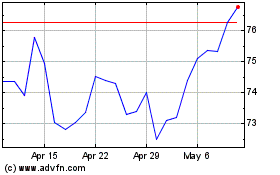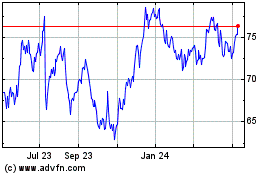Fed Approves Capital Plans for State Street, Bank of New York Mellon -- Update
June 29 2016 - 6:40PM
Dow Jones News
By Sarah Krouse
The U.S. Federal Reserve approved capital plans at State Street
Corp. and Bank of New York Mellon Corp. in the regulator's annual
stress test released Wednesday.
State Street and BNY Mellon's plans were approved after the Fed
found that the custody banks could each weather a severe economic
downturn. The approval clears the way for the Boston and New York
banks to reward investors by returning capital either through
dividend payouts, buying back stock or both.
After the results of the Fed test, State Street unveiled plans
to increase its quarterly dividend by four cents to 38 cents per
share starting in the third quarter of this year, pending board
approval. The bank also said its board approved the purchase of as
much as $1.4 billion in common stock between July 1 and June 30 of
next year.
BNY Mellon, meanwhile, said its board approved share repurchases
of as much as $2.14 billion in common stock over four quarters,
starting in the third quarter of this year. It also gave a green
light to repurchasing as much as $560 million of additional common
stock during that time if the bank issues $750 million in preferred
stock. It plans to increase its dividend as soon as the third
quarter by two cents per share to 19 cents.
"We plan to accomplish this while increasing our capital base to
meet higher regulatory requirements and to continue to perform
through stressed market scenarios," Chief Executive Gerald Hassell
said in a statement.
Northern Trust Corp. also had its capital plan approved
Wednesday. It is another bank that focuses on custody services, a
crucial component of Wall Street's plumbing.
At the low point of a hypothetical recession, State Street's
common equity Tier 1 ratio, which measures high-quality capital as
a share of risk-weighted assets, would be 6.6%, above the 4.5%
level the Fed views as a minimum. The new ratio, unlike the one
reported last week by the Fed in a related test, takes into account
the bank's proposed capital plan.
The common equity Tier 1 ratio for BNY Mellon at the low point
of a hypothetical recession would be 8.4%, also above the 4.5%
level the Fed views as a minimum. Last week, the Fed said BNY
Mellon has the capital to keep lending in a severe economic
downturn, in the first stage of its annual stress tests.
The latest stress-test results incorporate quantitative factors
assessed in data released by the Fed last week. These included a
simulation of how the bank's capital buffers would hold up under a
world-wide recession. The Fed's "severely adverse" scenario of
financial stress this year included a 10% U.S. unemployment rate,
significant losses in corporate and commercial real estate lending
portfolios, and negative rates on short-term U.S. Treasury
securities.
This second part of the test also included a qualitative
assessment by the Fed of a bank's capital-planning process and
internal controls. The Fed has the ability to object to a bank's
capital plan on either quantitative or qualitative grounds.
The Fed's results on Wednesday are arguably the more important
part of the testing since they dictate how much capital will be
returned to shareholders. Increased dividends and buybacks can help
to bolster a bank's share price.
State Street's common equity Tier 1 ratio in this year's test
was similar to last year's, which was 6.5%. BNY Mellon's common
equity Tier 1 ratio was lower this year than last year's 11.1%.
After passing the 2015 test, State Street and BNY Mellon both
announced share buybacks. State Street at the time said that it
would increase its quarterly dividend by four cents per share to 34
cents, while BNY Mellon left its quarterly dividend unchanged at 17
cents per share.
Write to Sarah Krouse at sarah.krouse@wsj.com
(END) Dow Jones Newswires
June 29, 2016 18:25 ET (22:25 GMT)
Copyright (c) 2016 Dow Jones & Company, Inc.
State Street (NYSE:STT)
Historical Stock Chart
From Mar 2024 to Apr 2024

State Street (NYSE:STT)
Historical Stock Chart
From Apr 2023 to Apr 2024
